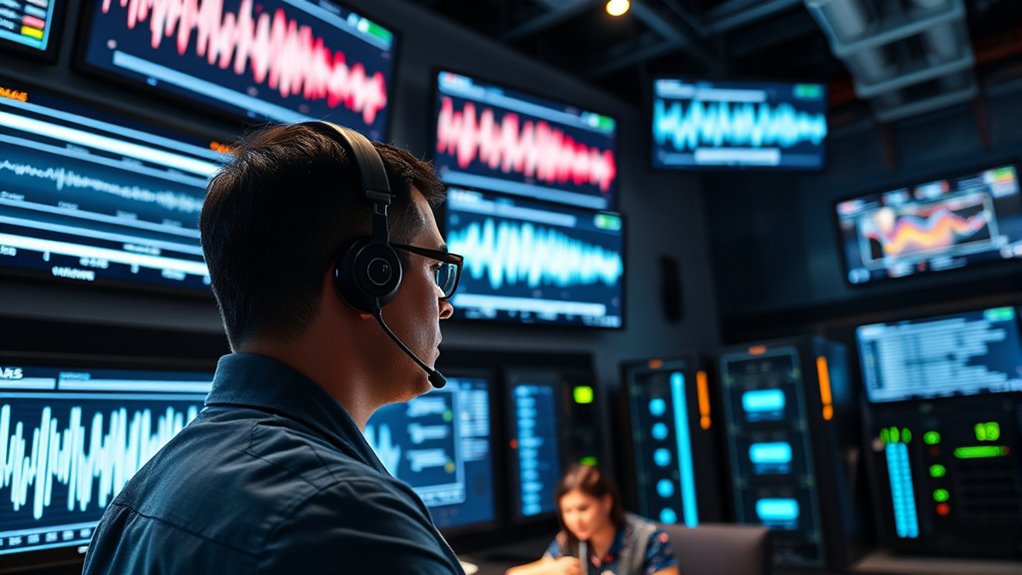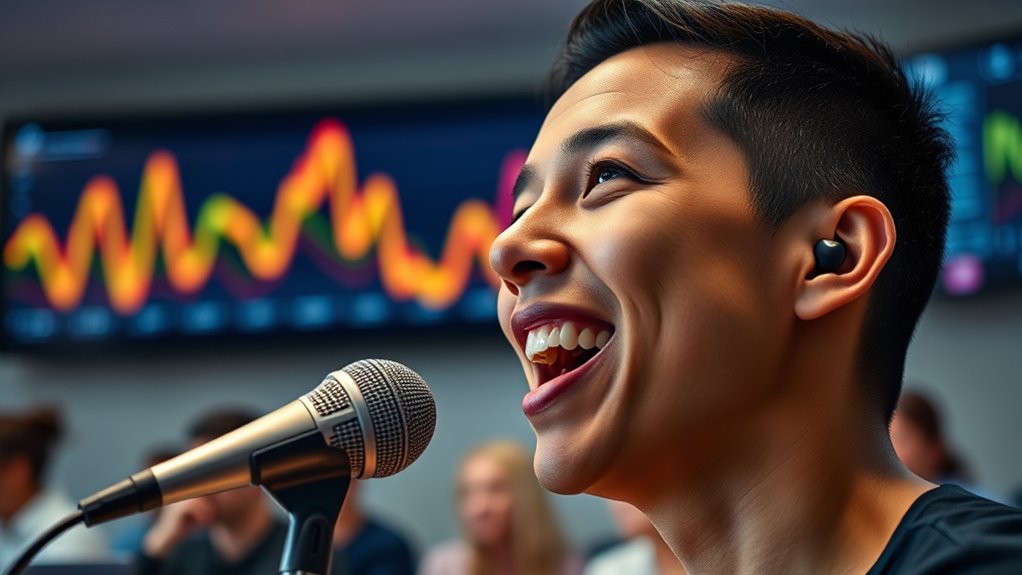Real-time captioning uses automatic speech recognition (ASR) technology to instantly turn spoken words into written text during live events. As the audio plays, ASR analyzes the sound with advanced algorithms, recognizing speech patterns, accents, and background noise. It then quickly converts this into accurate captions, which are displayed on screens for viewers. Continuous learning and updates improve accuracy over time. If you keep exploring, you’ll discover more about how this technology keeps pace with live speech seamlessly.
Key Takeaways
- ASR analyzes live audio streams using advanced algorithms to recognize speech patterns, accents, and pronunciations in real time.
- It converts spoken words into text instantly, ensuring captions keep pace with live speech without noticeable lag.
- Background noise filtering improves accuracy, allowing the system to focus on the speaker’s voice during dynamic environments.
- Machine learning enables the system to learn from data, enhancing recognition of diverse accents and complex speech patterns over time.
- The captions are dynamically updated and synchronized with live audio, providing continuous, reliable text for viewers.

Real-time captioning has become an essential tool for making live events and broadcasts accessible to everyone. At the heart of this technology is speech recognition, a powerful tool that transforms spoken words into written text almost instantaneously. When you attend a live conference, watch a televised event, or participate in an online meeting, real-time captioning guarantees you don’t miss any important details, regardless of your hearing ability. This accessibility technology bridges communication gaps, enabling everyone to follow along seamlessly.
Real-time captioning makes live events accessible, ensuring everyone can follow along seamlessly regardless of hearing ability.
The core process begins with speech recognition algorithms that analyze the audio feed. These algorithms are trained to recognize various speech patterns, accents, and pronunciations, which helps improve accuracy in real-world scenarios. As the speaker talks, the system processes the audio in real time, converting spoken words into text at a rapid pace. This process requires sophisticated software capable of filtering out background noise and distinguishing speech from other sounds, ensuring the captions are as accurate as possible. The system’s ability to adapt to different speakers and environments is vital for providing reliable captions during live events.
Once the speech recognition engine transcribes the spoken words, the text is displayed on a screen for viewers to read. The speed at which this happens is essential; the captions need to keep pace with the speaker without lagging behind. To achieve this, the technology continuously updates and refines the transcription, often using advanced algorithms that predict and correct errors on the fly. This dynamic process allows viewers to follow the conversation in real time, making the event more inclusive and engaging. The entire workflow relies heavily on accessibility technology that is designed to be fast, accurate, and easy to integrate into various platforms.
You might not realize how much work goes into making real-time captioning look effortless. Behind the scenes, speech recognition systems are constantly learning and improving through machine learning. They analyze vast amounts of data to better understand different speech patterns and vocabulary, which enhances their performance over time. This ongoing development guarantees that captions become more precise and reliable, especially in noisy environments or in cases where speakers have strong accents. With such advancements, real-time captioning continues to evolve, becoming more effective at serving diverse audiences.
Frequently Asked Questions
How Accurate Is Real-Time Captioning Across Different Accents?
Real-time captioning accuracy can vary with different accents because of accent variability and dialect recognition challenges. You might find some accents are captured more accurately than others, especially if the ASR system isn’t trained on diverse speech patterns. However, advances in machine learning are improving dialect recognition, making captioning more reliable across a wider range of accents. Still, slight inaccuracies can occur depending on the speaker’s pronunciation and clarity.
What Are the Common Challenges Faced by ASR Systems?
You encounter challenges with ASR systems due to user diversity and language complexity. Variations in accents, speech patterns, and background noise can diminish accuracy. Additionally, complex language structures, idioms, and technical jargon make it harder for ASR to transcribe correctly. These factors require ongoing improvements in algorithms and training data to guarantee ASR systems serve a broad user base effectively and handle diverse linguistic nuances smoothly.
How Does Noise Affect Real-Time Captioning Performance?
Noise can profoundly impact your real-time captioning performance by reducing audio clarity and introducing background interference. When there’s too much noise, your ASR system struggles to accurately recognize spoken words, leading to errors or delayed captions. To improve results, minimize background noise and guarantee clear audio input. This helps your system better distinguish speech from interference, resulting in more accurate, timely captions for your audience.
Can ASR Adapt to Specialized Vocabulary or Jargon?
Yes, ASR can adapt to specialized vocabulary or jargon through domain adaptation and vocabulary expansion. When you provide the system with relevant data, it learns the specific terms used in your field. This process helps improve accuracy, especially in professional settings. By continuously updating its models with new terminology, ASR becomes more reliable at understanding and transcribing specialized language, making real-time captioning more effective for your needs.
What Are the Future Advancements Expected in Real-Time Captioning?
You’ll love the future of real-time captioning—multilingual support and contextual understanding will make it almost clairvoyant. Imagine ASR systems effortlessly switching languages and grasping subtle nuances, making communication seamless worldwide. Expect smarter algorithms that adapt instantly, recognizing slang, idioms, and complex jargon. Soon, you’ll barely notice the technology working behind the scenes, as captions become more accurate, inclusive, and intuitive—finally catching up with our ever-evolving language habits.
Conclusion
As you watch the words flow seamlessly across the screen, you can almost hear the lively chatter and quiet whispers captured in real time. Behind the scenes, ASR systems work tirelessly like a skilled translator, turning spoken language into text instantly. With each spoken phrase, you’re immersed in a world where communication stays clear and immediate, bridging gaps and connecting people. It’s like having a personal interpreter, making every conversation feel more vibrant, accessible, and alive.











